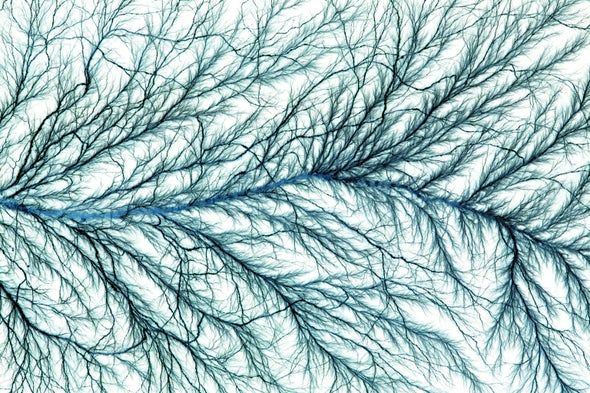Bacteria in the genus Geobacter look like miniature kidney beans sprouting long, wirelike tails—and it turns out these “nanowires” really do conduct electricity. Scientists have been studying such conductive bacteria for decades, hoping to develop living technology that can work safely inside the human body, resist corrosion or even literally pull electricity out of thin air. But to make this practical, they first must unlock the mystery of how these minuscule fibers actually work—and a vigorous debate is shaping up.
Geobacter's conductive abilities were discovered by Derek Lovley, a microbiologist at the University of Massachusetts Amherst, who wanted to know how these bacteria rid themselves of the electrons produced during their energy-generation process. Most microbes need to pass electrons to adjacent oxygen molecules to “breathe”—but Geobacter thrives in oxygen-free environments. Lovley eventually realized that these one-celled organisms produce long chains of proteins that carry the electrons to nearby rust molecules, which use the charged particles to transform into magnetite. Other protein nanowires have been discovered since, but Lovley thinks one kind, called pili, plays a primary role. The proteins that make up pili—called pilins—are too small to investigate with traditional imaging technology, so Lovley demonstrated their importance by removing the gene for making pili. Without it, Geobacter could no longer change rust into magnetite. Furthermore, he found that pili he gathered from the cells could indeed conduct electricity.
Researchers have already developed applications that use living conductive microbes, but Lovley wants to harvest the nanowires themselves to build environmentally friendly electronics. He recently co-authored two papers on sensors made from Geobacter nanowires: One, described in Nano Research, detects ammonia; the other, detailed in Advanced Electronic Materials, picks up changes in humidity. Another device, which his group described in Nature, uses nanowires to pull electrons from water molecules in the air—thus producing electricity from humidity. “It has some advantages over the other sustainable forms of electricity production, such as solar or wind, because it's a 24/7 continuous process,” Lovley explains. “And it will work in just about any environment on earth.”
He suggests nanowires, instead of batteries, could power some devices. “Already we can use the protein nanowires [to produce power] for small-scale electronics, like a wearable patch for medical monitoring,” he says, adding that nanowires can function in living tissue without triggering a bad reaction and are more biodegradable than metals.
Lovley says companies have expressed interest in such applications. But some scientists are skeptical about separating nanowires from the bacteria that generate them. “Taking proteins that have electrical properties out of their natural context—they [then] have to compete with synthetic materials” for efficiency, explains Sarah Glaven, a U.S. Naval Research Laboratory biologist. Nanowires would “be hard-pressed to compete with something like a conductive metal.” She has previously worked with Lovley but is not involved in his current research, instead focusing on genetically modifying conductive bacteria for applications such as marine sensors.
Glaven notes that nanowires would have an advantage in environments such as the ocean or human body, which corrode traditional electronics. But even in that setting, she says, nanowires would still vie with materials such as biocompatible polymers. She prefers working with living microbes because “you don't just have an electron-carrying material—you have the whole information-processing suite within the cell itself.”
Although researchers are already finding applications for both living cells and harvested nanowires—and have even explored modifying the prolific bacterium Escherichia coli to produce pili—questions remain about which proteins make up the most productive nanowires. Understanding whether pili or another type of nanowire carries most of Geobacter's electricity could guide scientists choosing the best material for electronics.
“Everybody, including us, thought [the key nanowires] were pili,” says Nikhil Malvankar, a biophysicist who previously worked with Lovley but currently has his own laboratory at Yale University. Last year, however, Malvankar and his colleagues imaged Geobacter with an electron microscope; they concluded that rather than stringlike pilin proteins, stacks of proteins called cytochromes form the microbes' main electricity-transmission method. The researchers went on to examine a biofilm of the bacteria via genetic-modification experiments, as well as several imaging methods—Glaven says they “really threw the kitchen sink” at getting an accurate picture of the nanowires Geobacter was using. The Yale team pinpointed a specific hyperefficient conductor cytochrome called OmcZ, which Geobacter produces in response to an electrical field, as the biofilm's primary method of shedding electrons. “Seeing is believing, so I think microscope imaging is very important,” says co-author and Yale physicist Sibel Yalcin.
But researchers still do not agree on which nanowire is most significant. Some come down on the side of pili, others for cytochromes. Lovley is firmly in the pili camp: he says that when his team (which at the time included Malvankar) genetically modified Geobacter so it could not produce a certain type of cytochrome, it formed biofilms that were actually more conductive than those produced by unmodified bacteria. Glaven says her own lab found that electricity moves in a Geobacter biofilm “overwhelmingly” through cytochromes. But she notes that yet another lab, at Michigan State University, is doing work based on Lovley's pili hypothesis.
Based on his most recent research, Malvankar favors cytochromes—but he has not ruled out a role for pili. “All the filaments we found [when bacteria were actively conducting electricity] were cytochromes,” he says. “But is it possible that maybe under some conditions, it could be making pili? That's actually an open question.”
The drive to figure out Geobacter's conductive proteins could help researchers develop more efficient living electronics. And even without complete knowledge of conductive microbes' mysteries, bacteria-based electronic devices may soon be possible. It is still early, Lovley says, “but so far everything's been working out. I've had amazing colleagues who just know how to do things with electronic materials. Every couple of weeks they come up with something new.”


